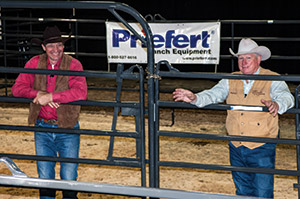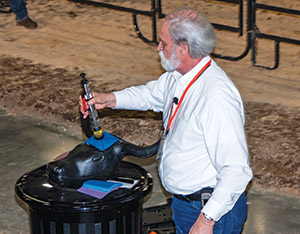Handling Livestock in an Emergency
BQA session offers tips to emergency-response personnel, cattlemen in how to best handle cattle and want-to-be helpers in an emergency situation.

Curt Pate (left) and Ron Gill offer tips to emergency-response personnel and cattlemen in how to best handle cattle and want-to-be helpers in an emergency situation. ”
NASHVILLE, Tenn. (Feb. 4, 2014) — Could you provide effective assistance at the site of an accident involving a truck or stock trailer loaded with cattle? A wrong response, no matter how well-intentioned, can endanger humans as well as the animals involved. With that in mind, a Beef Quality Assurance (BQA) training session for law enforcement officials and other emergency personnel, as well as cattle producers, was offered Feb. 4 during the 2014 Cattle Industry Convention, in Nashville, Tenn. Attendees were schooled in procedures for freeing animals trapped in vehicles, containing animals running loose, and administering humane euthanasia to severely injured animals.
Texas AgriLife Extension Educator Ron Gill and stockmanship clinician Curt Pate talked potential first-responders through several scenarios, imparting tips for understanding animal behavior. Frightened cattle running loose in the wake of an accident is one of the most common situations first-responders might face. Gill said animal panic is only worsened by sirens, flashing lights and a throng of yelling, arm-waving people. Sometimes one or more panicked animal ends up being shot when that scenario might have been avoided. Sometimes humans are hurt or killed by panicked animals.
“Giving stressed animals some space and allowing them to calm down for 30 to 45 minutes is often the best approach,” advised Gill. “A crowd of people wanting to help, but not knowing how to do it, can be a big problem.”
Pate related an experience involving the rollover of a truck hauling fat cattle that occurred in a busy downtown area. Plenty of people wanted to do the right thing. Very few were, because it wasn’t a coordinated effort.
“One person needs to take charge and control the actions of people,” said Pate.
Among the recommendations offered by Pate and Gill were the following:
- Maintain a minimum distance and loose-herd animals while finding or creating a place for them to go.
- Portable panels often are brought in to contain loose animals. Make sure they are anchored as well as possible. Remember, once corralled, cattle are still capable of moving or tearing down the panels.
- Recognize the signs that an animal is going on the fight, including an elevated head, erect ears, tightened jaw muscles and switching tail.
-
Never step in front of a running animal. It probably won’t stop.

J.K. Shearer, Iowa State University, talked about humane euthanasia of severely injured animals.
- Try to work animals as a group rather than singly. A lone animal is more likely to panic and become dangerous.
- Don’t direct car headlights or spotlights directly at animals as the lights could temporarily blind them.
- Remember, human life and safety must take precedence over that of the cattle.
Pate and Gill also demonstrated low-stress stockmanship techniques for keeping animals calm while herding, penning or loading into a trailer.
J.K. Shearer, of Iowa State University, talked about humane euthanasia of severely injured animals, describing the proper technique for using firearms or a captive bolt device.
Editor’s Note: The above article was written under contract or by staff of the Angus Journal. It may not be reprinted without express
permission of the Angus Journal. To request reprint permission, contact the editor at 816-383-5200.
www.4cattlemen.com is an event coverage site provided by the Angus Journal editorial team,which publishes the Angus Journal, the Angus Beef Bulletin, the Angus Beef Bulletin EXTRA and the Angus Journal Daily. For questions about this site, to submit an article for our consideration, or to report a broken link, contact the editor at 816-383-5200; 3201 Frederick Ave., Saint Joseph, MO 64506.
The Angus Journal claims copyright
to this website as presented. We welcome educational venues and
cattlemen to link to this site as a service to their audience.

